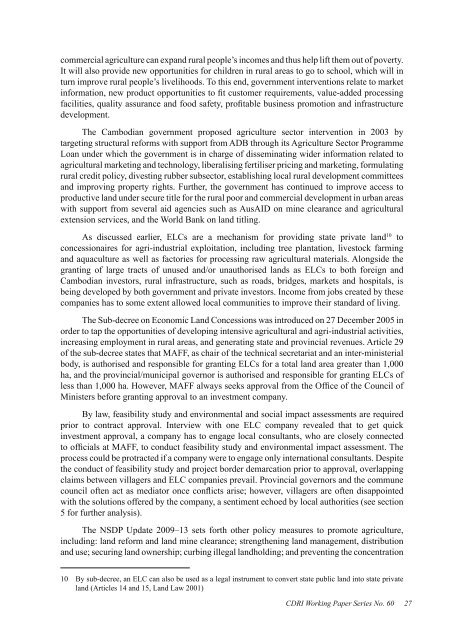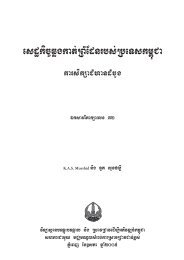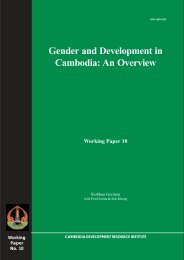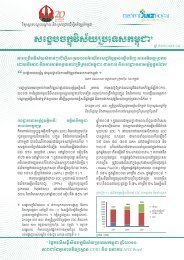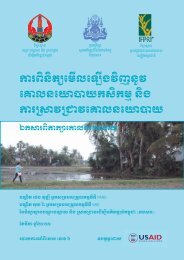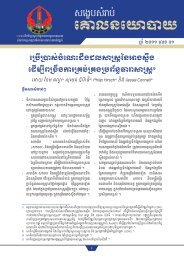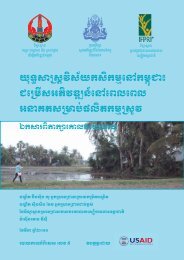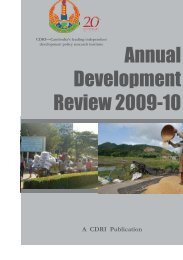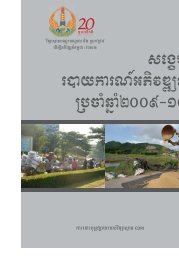Foreign Investment in Agriculture in Cambodia CDRI Working Paper ...
Foreign Investment in Agriculture in Cambodia CDRI Working Paper ...
Foreign Investment in Agriculture in Cambodia CDRI Working Paper ...
Create successful ePaper yourself
Turn your PDF publications into a flip-book with our unique Google optimized e-Paper software.
commercial agriculture can expand rural people’s <strong>in</strong>comes and thus help lift them out of poverty.<br />
It will also provide new opportunities for children <strong>in</strong> rural areas to go to school, which will <strong>in</strong><br />
turn improve rural people’s livelihoods. To this end, government <strong>in</strong>terventions relate to market<br />
<strong>in</strong>formation, new product opportunities to fit customer requirements, value-added process<strong>in</strong>g<br />
facilities, quality assurance and food safety, profitable bus<strong>in</strong>ess promotion and <strong>in</strong>frastructure<br />
development.<br />
The <strong>Cambodia</strong>n government proposed agriculture sector <strong>in</strong>tervention <strong>in</strong> 2003 by<br />
target<strong>in</strong>g structural reforms with support from ADB through its <strong>Agriculture</strong> Sector Programme<br />
Loan under which the government is <strong>in</strong> charge of dissem<strong>in</strong>at<strong>in</strong>g wider <strong>in</strong>formation related to<br />
agricultural market<strong>in</strong>g and technology, liberalis<strong>in</strong>g fertiliser pric<strong>in</strong>g and market<strong>in</strong>g, formulat<strong>in</strong>g<br />
rural credit policy, divest<strong>in</strong>g rubber subsector, establish<strong>in</strong>g local rural development committees<br />
and improv<strong>in</strong>g property rights. Further, the government has cont<strong>in</strong>ued to improve access to<br />
productive land under secure title for the rural poor and commercial development <strong>in</strong> urban areas<br />
with support from several aid agencies such as AusAID on m<strong>in</strong>e clearance and agricultural<br />
extension services, and the World Bank on land titl<strong>in</strong>g.<br />
As discussed earlier, ELCs are a mechanism for provid<strong>in</strong>g state private land 10 to<br />
concessionaires for agri-<strong>in</strong>dustrial exploitation, <strong>in</strong>clud<strong>in</strong>g tree plantation, livestock farm<strong>in</strong>g<br />
and aquaculture as well as factories for process<strong>in</strong>g raw agricultural materials. Alongside the<br />
grant<strong>in</strong>g of large tracts of unused and/or unauthorised lands as ELCs to both foreign and<br />
<strong>Cambodia</strong>n <strong>in</strong>vestors, rural <strong>in</strong>frastructure, such as roads, bridges, markets and hospitals, is<br />
be<strong>in</strong>g developed by both government and private <strong>in</strong>vestors. Income from jobs created by these<br />
companies has to some extent allowed local communities to improve their standard of liv<strong>in</strong>g.<br />
The Sub-decree on Economic Land Concessions was <strong>in</strong>troduced on 27 December 2005 <strong>in</strong><br />
order to tap the opportunities of develop<strong>in</strong>g <strong>in</strong>tensive agricultural and agri-<strong>in</strong>dustrial activities,<br />
<strong>in</strong>creas<strong>in</strong>g employment <strong>in</strong> rural areas, and generat<strong>in</strong>g state and prov<strong>in</strong>cial revenues. Article 29<br />
of the sub-decree states that MAFF, as chair of the technical secretariat and an <strong>in</strong>ter-m<strong>in</strong>isterial<br />
body, is authorised and responsible for grant<strong>in</strong>g ELCs for a total land area greater than 1,000<br />
ha, and the prov<strong>in</strong>cial/municipal governor is authorised and responsible for grant<strong>in</strong>g ELCs of<br />
less than 1,000 ha. However, MAFF always seeks approval from the Office of the Council of<br />
M<strong>in</strong>isters before grant<strong>in</strong>g approval to an <strong>in</strong>vestment company.<br />
By law, feasibility study and environmental and social impact assessments are required<br />
prior to contract approval. Interview with one ELC company revealed that to get quick<br />
<strong>in</strong>vestment approval, a company has to engage local consultants, who are closely connected<br />
to officials at MAFF, to conduct feasibility study and environmental impact assessment. The<br />
process could be protracted if a company were to engage only <strong>in</strong>ternational consultants. Despite<br />
the conduct of feasibility study and project border demarcation prior to approval, overlapp<strong>in</strong>g<br />
claims between villagers and ELC companies prevail. Prov<strong>in</strong>cial governors and the commune<br />
council often act as mediator once conflicts arise; however, villagers are often disappo<strong>in</strong>ted<br />
with the solutions offered by the company, a sentiment echoed by local authorities (see section<br />
5 for further analysis).<br />
The NSDP Update 2009–13 sets forth other policy measures to promote agriculture,<br />
<strong>in</strong>clud<strong>in</strong>g: land reform and land m<strong>in</strong>e clearance; strengthen<strong>in</strong>g land management, distribution<br />
and use; secur<strong>in</strong>g land ownership; curb<strong>in</strong>g illegal landhold<strong>in</strong>g; and prevent<strong>in</strong>g the concentration<br />
10 By sub-decree, an ELC can also be used as a legal <strong>in</strong>strument to convert state public land <strong>in</strong>to state private<br />
land (Articles 14 and 15, Land Law 2001)<br />
<strong>CDRI</strong> Work<strong>in</strong>g <strong>Paper</strong> Series No. 60<br />
27


